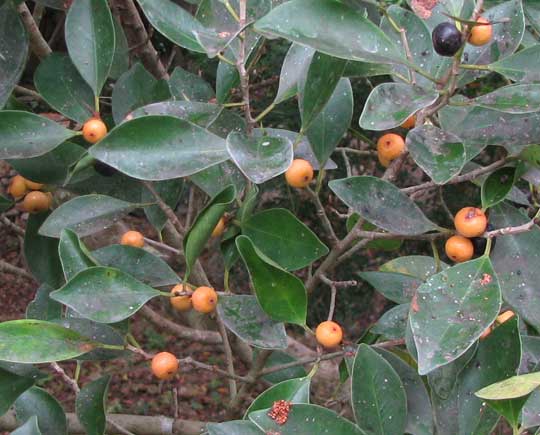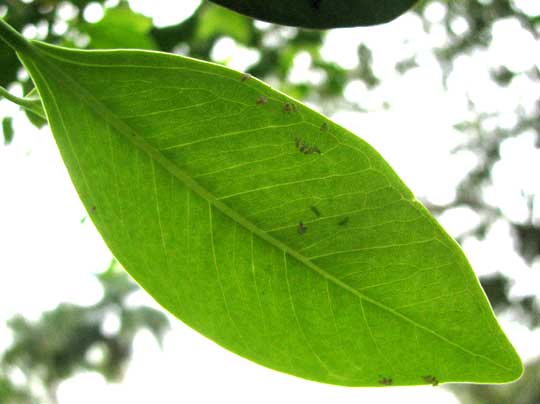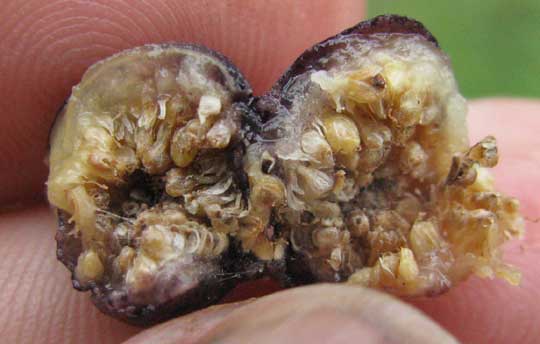Excerpts from Jim Conrad's
Naturalist Newsletter

from the January 30, 2011 Newsletter issued from Hacienda Chichen Resort beside Chichén Itzá Ruins, central Yucatán, MÉXICO; limestone bedrock, elevation ~39m (~128ft), ~N20.676°, ~W88.569°
FIG BANQUET
Exactly in front of the Hacienda's entrance stand some large, densely leaved, picturesque trees inside which these days there's a continual hubbub of branch-shaking, chirping birds overindulging in figs. The trees are just loaded with soft, juicy figs perfectly sized for a bird's mouth, but without any sweetness or flavor to attract a human. You can see a branch showing how thickly figs grow on it, and how bird poop so generally splatters the leaves, below:

You can see that in this species' semi-mature figs are pale orange while mature ones are nearly black.
The fig trees themselves are "strangler figs," as seen at the top of the page. We've already dealt with the wonders of stranglers at www.backyardnature.net/yucatan/stranglr.htm.
But, identifying a tree as a strangler fig isn't saying much. Eight fig species -- eight members of the genus Ficus and mostly stranglers-- are listed for the adjacent state of Quintana Roo, and I suppose Yucatán state is home to about the same number. However, our big stranglers are none of those.
A naturalist leading a birding group passed through the other day calling the trees Ficus benjamina, which are big stranglers planted throughout the world's tropics and possibly the most planted of all trees in pots of big Northern hotels and malls. However, the leaves of that famous fig gradually end in long, slender points and display over 30 veins along each side of the midribs, while our fig's leaves end with short, rounded tips and have only ten or so prominent veins along each side of their midribs, as shown below:

Our bird-pleasing strangler fig turns out to be what's sometimes called the Chinese Banyan. It's FICUS MICROCARPA, in old books referred to as F. retusa. Like F. benjamina, Chinese Banyan is from the southern Asia, northern Australia region, and also widely planted in the tropics worldwide. It's much utilized as a bonsai subject.
You probably know that fig trees can't produce viable seeds unless a particular species of wasp that has coevolved with the fig is available for pollination. The wasp enters the fig through a hole at its tip, then walks around atop the many tiny fig flowers lining the fig's walls and pointing inward toward the empty space in the fig's center. You can see the cross section of a fig from one of our Chinese Banyans showing the empty space and matured fruits inside the fig below:

Well, if our figs appear to be full of seeds, then the appropriate wasp pollinator must also be present. That's true. In fact, Chinese Banyans are escaping from cultivation throughout the world's tropics as in one place after another the wasp also is turning up, and then the tree's fertile seeds get spread by birds and bats. Reproducing Chinese Banyans have even gone wild in Florida. The tree's wasp pollinator was first noticed in Mexico around 1985.
Despite my general antipathy toward invasive organisms, when our big Chinese Banyans are exploding with birds eating figs inside them and the asphalt driveway beneath them is splattered and messy with squashed figs and bird droppings full of fig seeds, and mixed flocks of fifty or more Indigo, Blue and Painted Buntings contentedly feed below them, I can't help but feel a bit kindly toward the invaders.
However, I still worry about this invasive's effect on the local ecology. Does its attracting all those feeding birds mean that other local plants needing their seeds disseminated will suffer? Bird poop is generally pasty and lumpy, but the seed-rich poop splattered on the Chinese Banyans' leaves is runny. Are birds eating these figs getting nutritionally balanced meals, or are they feeding on the equivalent of junk food? Our local birds and these Chinese Banyans didn't co-evolve.
You just never know what far-reaching effects any invasive species introduces into a preexisting ecosystem. These Chinese Banyans, however, make a good first impression.